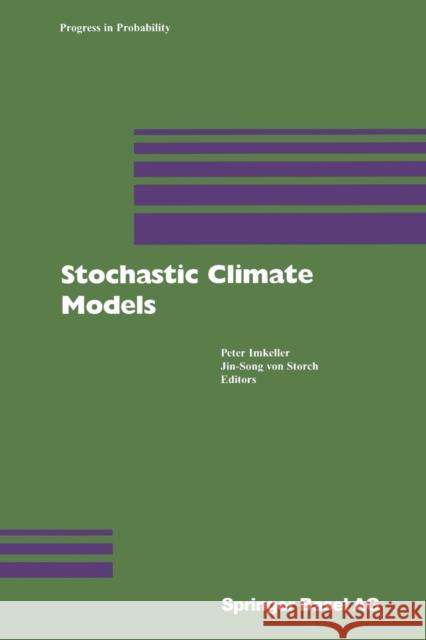Stochastic Climate Models » książka



Stochastic Climate Models
ISBN-13: 9783034895040 / Angielski / Miękka / 2012 / 398 str.
Stochastic Climate Models
ISBN-13: 9783034895040 / Angielski / Miękka / 2012 / 398 str.
(netto: 498,38 VAT: 5%)
Najniższa cena z 30 dni: 501,19
ok. 22 dni roboczych
Dostawa w 2026 r.
Darmowa dostawa!
A collection of articles written by mathematicians and physicists, designed to describe the state of the art in climate models with stochastic input. Mathematicians will benefit from a survey of simple models, while physicists will encounter mathematically relevant techniques at work.
"The proceedings of the workshop on Stochastic Climate Models, held in Chorin in 1999, present an exiting and stimulating summary of probabilistic developments in climate physics. Stochastic processes, stochastic and partial differential equations, random dynamical systems, local and large deviations asymptotic procedures, have comprised the most actice mathematical areas in teh field over the past 30 years, since Klaus Haselmann suggested a climate stochastic model where weather fluctuations randomly force the climate in the same way that fluid modecules forse Brownian pollen particles. . . The structure of the book reflects its aim to review and explain recent matheamtical additions to the list of tools for climate modelling, to help the climate physicists to understand what these tools are about. . . The book is strongly recommended as an excellent source or information and inspiration, both to mathematicians and physicists interested in the field."
---EMS NEWSLETTER
1 The Hierarchy of Climate Models.- A gallery of simple models from climate physics.- 1 Introduction.- 2 Fluid dynamics and thermodynamics.- 3 Reduced physics equations.- 4 Integrated models.- 5 Low-order models.- References.- Simple climate models.- 1 Climate and climate modelling.- 2 Zero-dimensional energy balance climate model.- 3 Quasi-geostrophic two-layer atmosphere in a channel.- 4 Reduced gravity ocean in a square basin.- 5 Summary and outlook.- References.- Complex climate models’ tools for studying the origin of stochasticity in the climate system.- 1 Introduction.- 2 Origin of complexity.- 3 Cosequence of complexity.- 4 Concluding remarks.- References.- Some mathematical aspects of the GCMs.- 1 Introduction.- 2 Hierarchy of PDEs in the GCMs.- 3 The PEs and PEV2s of the ocean.- 4 The PEs and PEV2s of the atmosphere.- 5 Coupled atmosphere-ocean (CAO) models.- References.- 2 The Emergence of Randomness: Chaos, Averaging, Limit Theorems.- Hasselmann’s program revisited: the analysis of stochasticity in deterministic climate models.- 1 Introduction.- 2 Stochasticity in deterministic climate models with two separate time scales.- 3 The method of averaging.- 4 Normal deviations from the averaged system: the central limit theorem.- 5 Large deviations from the averaged system.- 6 Extensions of Hasselmann’s program comments.- References.- Thermodynamic formalism, large deviation, and multifractals.- 1 Expanding dynamical systems.- 2 Pointwise dimension.- 3 Multifractal formalism.- 4 Local large deviation.- References.- Summary.- Averaging and climate models.- 1 Introduction.- 2 The averaging setup.- 3 Fully coupled systems.- 4 Appendix A: hyperbolicity.- 5 Appendix B: Proof of Theorem 3.1.- 6 Appendix B: Proof of Theorem 3.2.- References.- Dynamical systems with time scale separation: averaging, stochastic modelling, and central limit theorems.- 1 Introduction.- 2 Average skill of an averaged model.- 3 Stochastic modelling.- 4 Central limit theorems and their limits.- Conclusion.- Appendix: Remarks on the numerical implementation.- References.- 3 Tools and Methods: SDE, Dynamical Systems, SPDE, Multiscale Techniques.- Energy balance models — viewed from stochastic dynamics.- 1 Introduction.- 2 The paradigm of stochastic resonance.- 3 Deterministic energy balance models.- 4 Stochastic extensions of EBM.- 5 Stochastic resonance: Freidlin’s approach.- References.- Exponential stability of the quasigeostrophic equation under random perturbations.- 1 Introduction.- 2 Preliminaries.- 3 Transformation of the quasigeostrophic equation.- 4 The stationary solution.- 5 Discussion.- References.- A mini course on stochastic partial differential equations.- 1 Introduction.- 2 Cauchy problem and semigroups.- 3 Infinite dimensional Wiener processes.- 4 Stochastic integration.- 5 First order stochastic equations.- 6 Heat equation with space-time white noise.- 7 Stationary solutions of a wave equation.- 8 Nonlinear stochastic pdes.- 9 Appendix.- References.- Hasselmann’s stochastic climate model viewed from a statistical mechanics perspective.- 1 Introduction.- 2 The microscopic description.- 3 The mesoscopic description.- 4 A derivation of the Langevin equation.- 5 The macroscopic description.- 6 Statistical mechanics.- 7 Discussion.- References.- 4 Reduced Stochastic Models and Particular Techniques.- Constrained stochastic forcing.- 1 Introduction.- 2 Charney-DeVore model.- 3 Discussion.- References.- Stochastic resonance and noise-induced phase coherence.- 1 Introduction.- 2 Stochastic resonance in the framework of synchronization phenomena.- 3 Conclusions.- References.- Stochastic confinement of Rossby waves by fluctuating eastward flows.- 1 Introduction.- 2 Spectral model.- 3 Superrotation flow.- 4 Interpretation.- 5 Conclusions.- References.- Some mathematical remarks concerning the localization of planetary waves in a stochastic background flow.- 1 Introduction.- 2 Some remarks concerning path properties of R.- 3 Transformation into Sturm-Liouville problems.- 4 Critical lines for ? = 0.- 5 Critical lines for general ?.- 6 The spectrum of L.- 7 The spectrum of K.- References.- Rossby waves in a stochastically fluctuating medium.- 1 Introduction.- 2 The stochastic differential equations.- Results.- Summary and discussion.- Appendix A.- References.- Passive tracer transport in stochastic flows.- 1 Introduction.- 2 Lagrangian vs. Eulerian picture.- 3 Slowly varying spatial variables.- 4 Richardson function of an advected scalar.- 5 Statistical topography of passive tracer fields.- 6 Other directions.- References.
1997-2025 DolnySlask.com Agencja Internetowa
KrainaKsiazek.PL - Księgarnia Internetowa









